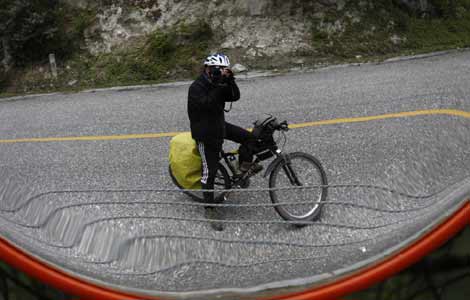Herdsmen sacrifice homeland for spaceflight base
Updated: 2011-09-30 11:29
(Xinhua)
|
|||||||||
EJINA Banner, Inner Mongolia Autonomous Region - As China launched its first space lab module into outer space, 78-year-old Grandma Chagan was still dreaming of her homeland which was given up for the construction of the country's spaceflight base 53 years ago.
"I remember that it happened in 1958 when helicopters landed near my yurt and workers began exploring the base site. Then we received an order to remove. We took apart our yurts, packed our households, picked up our kids and herded the sheep and camels along - leaving our homes forever," said Chagan in Mongolian language, when recalling her childhood homeland in Ejina banner in Alxa league in Inner Mongolia.
More than half a century ago the Chinese government selected the area around the Banyan Bogd Mountain near the desert of Ejina, some 2,000 km away from Beijing, as the nation's first satellite launch site. More than 1,400 herdsmen of Tuerhute tribe of Mongolian had to move away from their homes and find new places to live. Since then, they wandered on the desert for eight years.
Their original homeland later became the well-known Jiuquan Satellite Launch Center, also known as Dongfeng Space City, where China tested the launching of its first surface-to-surface missile, first nuclear missile, first satellite, first long-range rocket and first manned spacecraft...
Wandering
Chagan said she used to live in Baori Ulan village with 200 other families and 70,000 sheep on 4 million hectares of pasture.
"The road of farewell to homeland stretched longer and longer as people got on their way," she said.
"The base constructors sent trucks to help us, transporting the old people and children, as well as the luggage. The rest followed the sheep and camels to the strange desert," said Chagan, who was 25 at that time. She said the desert was ruthless and it was difficult for them to find water.
"But our homeland was the most beautiful oasis," said 69-year-old Nanselma. She said that she was so reluctant to leave that she made several clay sheep and camels and put them under the jarrah bushes to keep watch of her abandoned home.
"They stayed instead of me," Nanselma said. She returned the following year and found that the animals were still there, but the weather had eroded them slightly. She carefully repaired their legs and horns.
Ten years later she returned again to find that the jarrah bushes had disappeared, and so had the clay animals.
Most of the herdsmen belonged to the Tuerhute tribe. The tribe moved to the Vilga River drainage area, which was a Russian territory in the 17th century. Dissatisfied with their life under the rule of the Czar, many of them returned to China in the 18th century and finally resided in the current Ejina area.
"Before they began to depart in the summer of 1958, old people unfolded their mostly clean and beautiful felts and knelt on them, kowtowing to the Bayan Bogede Mountain, where our homes were," Nanselma said.
Bayan Bogd means happy and sacred in the Mongolian language, and the mountain is one of the holy sites for the Mongolians. The great hero Genghis Khan held ceremonies to worship the heaven four times at the foot of the mountain during his journeys to conquer the world in the 13th century.
"They were on their knees, mumbling, for quite a long time...however, we were far, far away from our homes," she said.
The herdsmen and their livestock left the land, so did their Tibetan Buddhist temples.
The grandest temple in Ejina, Qiangchibunamudling Monastery, was also included in the area of the spaceflight base.
Kunga, a lama who was 22-year-old in 1958, said that base constructors came and helped transport the items from the temples to a smaller monastery 100 km away.
"We had a carpet which 100 people could sit on, a yurt which 100 people could sit in, a lot of bronze buddha statues taller than a real man, and many trombones, trumpet shells..." Kunga recalled. Many of them were destroyed or lost during the chaotic Cultural Revolution between 1966 and 1976.
Hundreds of lamas then left the monastery and went home to help their families to move. Although it was a terrible journey, Kunga still remembered one family had triplets on the bumpy road. "Two boys and one girl. They were still alive," he said.
After they arrived at their new residence Gurinai 140 km away from Bayan Bogede Mountain, the herdsmen set up sheepfolds with jarrah and dug holes into the sand to shield themselves from sandstorms and the cold.
"However, the winter was too cold. The condition was much worse than that of our former homeland. Many sheep died," Chagan said. "The new place was not good for grazing."
"Not only sheep, but also some people died," Nanselma said.
Herdsmen could not get used to the new place. Livestock were thin and people got sick. Four years later, people departed again to look for a better home. This time they headed for Mazongshan Mountain on the China-Mongolia border.
The some 500-km-long journey was taken by Nuomuhan for many times. As a village cardre, he led several people to explore the route, entering and exiting the desert. He also walked with the herdsmen to ensure their safety.
"People were divided into small groups of three or two with 300 sheep at most. Some had 100 to 200 sheep, in addition to camels and donkeys. They took care of each other on the road," he said.
The journey was "incredible," he said. "The sheep suffered walking across the rocks and sand. It was better for larger animals like camels but worse for the sheep. When we found a piece of land with grass and water, we immediately stopped for a rest."
"Mazongshan was also too cold. Many horses and camels froze to death. Some livestock were taken by wolves. The wolves ate everything - camels, sheep, goats, donkeys, horses. We chased after the wolves during the night with battery-powered torches," he said.
Another four years later, the herdsmen had to move again to a town named Saihantaolai in 1966.
A total of 117 people died in the eight years. Some died of diseases on the way.










